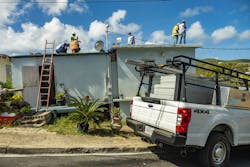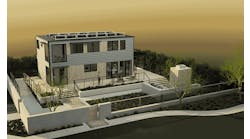In storm-ravaged Puerto Rico, those with microgrids help those without
During the outages that have hobbled Puerto Rico since Hurricane Fiona hit September 18, a fire station and 45 residents on the island of Culebra have benefited from power supplied by microgrids — and have shared the wealth with their neighbors, many of them still without electricity.
Puerto Rico was still rebuilding its infrastructure from the effects of Hurricane Maria, which devastated the island in September 2017. Then Hurricane Fiona, a category 1 hurricane, struck, again leaving most of the island without power and many without water.
The 45 residential microgrids — plus one at the fire station — in Culebra, located off the east coast of Puerto Rico, went into full backup mode when Fiona approached, said Dan Whittle, senior director for Caribbean initiatives at Environmental Defense Fund (EDF), which installed the microgrids.
“Our 45 people are bending over backward to help their neighbors,” said Whittle. The homes are resiliency hubs, each serving as a refuge for neighbors without solar. The neighbors can visit the microgrid users to plug in phones and meet their healthcare needs, he said. The microgrid users are low to moderate income, single parents, elderly and those with health needs.
“As long as there’s solar, the systems will continue to operate,” said Whittle. Not only do the microgrid users gain resilience. They also lower their bills. With the solar microgrids, some of the residents’ electricity bills dropped to zero while electricity prices in Puerto Rico have soared from 22 cents/kWh to 37 cents/kWh, he said.
Medical aid, water thanks to microgrids
Meanwhile, about 120 solar microgrids installed at Puerto Rico schools in 83 municipalities by Red Cross, Direct Relief and Blue Planet Energy are 100% operational and are providing shelter, food, drinking water and medical aid to communities across the island, said Christine Bennett, spokeswoman for Blue Planet.
Under the project — called the Solar Schools Project — the Puerto Rican housing authority designated the schools with microgrids as emergency shelters. They provide food and shelter to community members and serve as mission control centers for non-governmental organizations (NGO) needing to strategize, gather supplies and communicate plans for recovery.
Many of the microgrids that helped people through Hurricane Fiona were installed after Hurricane Maria devastated the island, said Whittle.
“Maria showed how important it is for Puerto Rico to withstand catastrophic events. It needs a community-based approach with a focus on critical facilities,” he said. “Fiona is proof that much more remains to be done to ensure the electric system is serving people.”
Staying in Puerto Rico after Fiona
EDF’s $1 million microgrid project was partially funded with a grant from Collibri Foundation, which offers education for young people facing challenges. EDF raised the rest from private donors.
One of the keys to successfully working in Puerto Rico and other storm-ravaged communities is ensuring that an on-the-ground team member remains in the community after the microgrids have been installed, said Whittle. In the case of EDF’s project, a local environmental coordinator helped identify vulnerable residents who could benefit from the microgrids. She’s now a consultant in Puerto Rico for EDF.
“For NGOs like us, you have to be part of the community,” he said. A mistake for many NGOs is donating and then leaving, Whittle added.
More microgrids coming
Blue Planet Energy and EDF are not alone in building resilience for the island. Many others have projects in the works, among them power management provider Eaton, Electriq Power and the Interstate Renewable Energy Council (IREC).
Eaton, which plans to become carbon neutral by the end of the decade, is developing microgrids at its Arecibo and Las Piedras manufacturing plants in Puerto Rico that are intended to provide resilience at the plants. They’re expected to be completed next year, said Greta Foster, product line manager, distributed energy resources for Eaton. The Arecibo plant makes circuit breakers
The microgrids are designed to withstand Category 5 hurricane-force winds, with controls and switchgear enclosures rated for extreme conditions and their battery storage systems raised on concrete pads and rated for marine environments. The solar PV system adjacent to the company’s facilities use racking that is structurally reinforced and secured deep in the ground rather than on the roof, Foster said.
“Fiona is proof that much more remains to be done to ensure the electric system is serving people.” — Dan Whittle, EDF
The existing generators and power system at the site will be updated with controls that allow the company to shed non-critical loads. If a generator goes down, solar PV and batteries will help the company continue to operate.
And Electriq Power, which provides integrated home energy storage, hopes to help out Puerto Rico with residential microgrids. In June, the company became the hardware and software provider for Barrio Eléctrico, which works with community partners to help Puerto Rican residents install solar and storage systems. Barrio Electrico has plans to help create a local solar industry.
And in February plans were underway for the town of Maricao, Puerto Rico, to deploy a microgrid offered through IREC.
Still waiting for federal dollars
The release of millions of federal dollars earmarked for the region after Hurricane Maria would help get microgrids built, according to Whittle. Disbursement of the funds has been slow.
Meanwhile, the microgrids that are now producing clean power provide benefits that ripple from their users to grateful community members. And they offer important messages to Puerto Rico, said Whittle.
“The microgrids offer lessons learned to Puerto Rico and elsewhere about the power of distributed energy resources and rooftop solar and storage,” said Whittle.
Track news about the growing role of microgrids during disasters. Subscribe to the free Microgrid Knowledge Newsletter.








